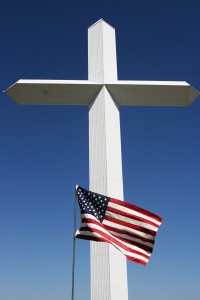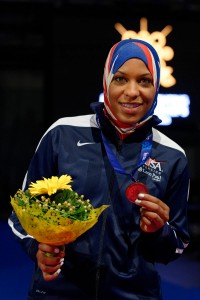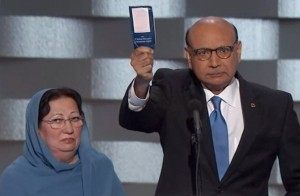 Hate crimes against American Muslims have spiked to their highest levels since the aftermath of the 9/11 attacks. While some of the rise is due to recent terrorist attacks, it is also connected with the heated rhetoric of the presidential race. Recent studies have noted that Muslims surpass atheists as the most unpopular group in the United States.
Hate crimes against American Muslims have spiked to their highest levels since the aftermath of the 9/11 attacks. While some of the rise is due to recent terrorist attacks, it is also connected with the heated rhetoric of the presidential race. Recent studies have noted that Muslims surpass atheists as the most unpopular group in the United States.
Muslims who are citizens of the state continue to be seen and treated as aliens of the nation. In the current fraught moment, the constitution of Islam as a legitimate American religion remains a fragile process.
Vigilance
“Our most effective weapon against terrorism is YOU,” says a billboard on a busy highway in New Jersey. It continues: “If you suspect it, report it.” And, further: “anonymous calls accepted.” At mass transit sites in New York and elsewhere signs constantly remind us, “If you see something, say something.” Such widespread delegation of the power to identify threats has important consequences; A power that is unofficially and anonymously exercised over others is being given to ordinary citizens. Their target is any suspect person, activity, or object.
This partial delegation of the powers of surveillance given to the public deepens the securitization of everyday life. And it leads to some shifts: As the author(ity) of security shifts, in part, from the state to the public, the criteria for identifying a threat shift from reason to sentiment.
In place of or in addition to the state’s rational or rationalized Islamophobia, we now have the public’s cultural or sentimental Islamophobia, and Muslims face new demands for legitimacy, tests of loyalty, and needs for legibility. You can defend yourself before the law with reason. But how do you defend yourself before a sensitive—and incensed— public?
Muslim legal citizenship risks being eclipsed by popular exclusion. The state’s legalism is challenged by the nationalism of the public. Occupying this liminal space—outside the nation and yet inside the state—puts a severe strain on American Muslims. In a manner similar to the “culturalization of citizenship” discussed by Rogers Brubaker, lay definitions of citizenship and the state’s definition of citizenship may easily collide. Membership now involves more than law. It places phenomenological demands on the psyche and calls for cultural conversion. More and more aspects of Muslims’ selves come under public scrutiny. Unlike the rational state, the sentimental public demands loyalty to the nation in various extra-rational forms, including sight, smell, speech, silence, appearance, and comportment. In other words, the rhetoric of citizenship is no longer about logos but extends also to ethos and pathos.
What does the public want from Muslims? They have to prove their loyalty to the nation before a public that demands transparency of Muslim existence. Islam and Muslims have to become legible.
To the extent that Islamophobia is no longer simply an attitude held by some Americans, but has been equipped with the power of an informal security apparatus, Muslim responsibility and loyalty to the United States becomes more complex and fragile, and shifts toward the psychic.
Indeed, the federal government, while demanding vigilance from its citizens, sometimes feels the need to intervene to protect Muslims from the public’s excesses. In Bensalem, Pennsylvania, a Muslim congregation has pleaded with township officials to allow the construction of a mosque. They paid for expensive traffic studies, repeatedly explained Islamic practices, and revised design plans multiple times, only to face rejection. Two months ago, the Justice Department stepped in, charging that the township zoning board had violated land-use laws by denying the congregation’s application, while it had granted zoning exemptions for other religious construction projects. As a member of the Muslim congregation told a reporter, “We were just asking for our mosque and we just wanted to be treated like everyone else.”
Here is the problem Muslims face: not being (or not being seen as being) like everyone else. The desire to become ordinary and unnoticeable has become an issue of survival. I call this the problem of Muslim opacity.
Opacity
In a recent story in the New York Times, the mayor of a small town in France relayed his impressions of a Muslim woman he had encountered on a beach.
“[He] said he ‘was on the beach on Sunday speaking to lifeguards, when I saw a woman dressed in black from head to toe; she was wearing a burqa and looking out towards the ocean.’ The woman’s garb, took him by surprise . . . although she was not doing anything disturbing. ‘It was a beautiful, warm, sunny day,’ he said. ‘We are in a small town and the beach is a small, family friendly place’ . . . The woman’s attire, he said, did not correspond with ‘what one normally expects from a beachgoer.’”
The Muslim woman’s appearance in the landscape of French laïcité is like a stain on an otherwise pure picture. It disturbs the mayor’s gaze—a speck of obscurity that needs to be removed. [Read “Regulating symbols: The burkini and niqab bans in France” by Stephanie Frank for more on this topic]
In the United States, there has been an upsurge in cases of mistaken identification of terrorists by the public. These unofficial sightings have resulted in people (Muslim and otherwise) being kicked off planes, suspended from school, and humiliated in public. At the root of all these misidentifications is a similar sense that what the Muslim presents is “not what one normally expects” in a given setting.
The world of aviation is especially rich in such cases. To give but a few examples:
Guido Menzio, an ethnic-Italian professor of economics from the University of Pennsylvania, was solving mathematical equations on his notepad while flying from Philadelphia to Syracuse. He was reported to authorities by his seatmate, a woman who found his notes cryptic. Not recognizing the script—and assuming the man to be of Middle Eastern origin—she took it to be either Arabic or a terrorist code.
A University of California, Berkeley student of Iraqi origin was removed from a Southwest Airlines flight in Los Angeles after another passenger became alarmed when she heard him speaking Arabic. The student, who was talking to his uncle, ended his conversation with “inshallah,” which means “God willing.” The passenger reported that she heard “potentially threatening comments.”
And in March of 2016, two Muslim women were escorted off a JetBlue flight from Boston to Los Angeles after a cabin crew member “didn’t like the way [they] were staring back at her.”
Writing in an unusual script, speaking Arabic, staring . . . all can threaten a security-conscious public. There are other genres of misidentification as well, some with more tragic consequences. A few months back, Khalid Jabarra, the son of a Lebanese-American family in Tulsa, Oklahoma, was killed by a neighbor who called the Jabarra family “filthy Arabs” and “Moose-lims” and told police that “they throw gay people off roof tops.” The Jabarra family was Christian. Not only, it seems, does the Muslim appear illegible, but the illegible also becomes Muslim.
And what is the Muslim response to the plight of opacity? Fleeing to legibility, they seek and wear uniforms.
Uniforms
Members of lower classes, subordinate racial and ethnic groups often find consolation, compensation, and security in uniforms. Uniforms hide, neutralize, and normalize different selves under a legible generic cloth. The task that citizenship performs legally and invisibly is reiterated visibly and locally by the uniform.
 This past summer brought us two symbolically rich cases: the example of Ibtihaj Muhammad, the first-ever hijabi member of an American Olympic team; and the now-infamous confrontation between the Khan family, whose son, an Army captain, was killed in Iraq, and Donald Trump, who wants to bar Muslims from the United States.
This past summer brought us two symbolically rich cases: the example of Ibtihaj Muhammad, the first-ever hijabi member of an American Olympic team; and the now-infamous confrontation between the Khan family, whose son, an Army captain, was killed in Iraq, and Donald Trump, who wants to bar Muslims from the United States.
Wrapping oneself in America’s sacred symbols to undo foreignness and fend off attacks is not a surprising strategy. A uniform is a visual elimination of difference and institutional claim to sameness. Uniforms filter Muslims into Americanness.
So Ibtihaj Muhammad’s fencing helmet perfectly and patriotically covers her hijab. At the same time, we see an increasing use of stars-and-stripes patterned headscarves by young American Muslim women. Those who cover for religious reasons now, literally, wrap themselves in the flag.
Similarly, the presence and sacrifice of Muslims in the American military becomes a crucial ground for proving the sincerity of their claims to membership in the nation. Yet while his son Humayun Khan was protected by his military uniform and ultimate sacrifice, Khizr Khan, the father, felt it necessary all along to carry a copy of the Constitution in his pocket, like an amulet against Islamophobia. When Mr. Khan, in his public shaming of Trump, pulled out that pocket Constitution on the stage of the Democratic National Convention, he proved himself irreproachably American.
Only by such conspicuous patriotism can Muslim bodies save themselves from illegibility and suspicion. And so, at the community level, we see a proliferation of Muslim soldiers, law enforcement officers, nurses, and firefighters stepping forward to represent Muslims.
Muslim identity has become unavoidable in American public culture. Muslims are part of American life as both villains and heroes, as the two parties’ national conventions amply attested. As Islam continues to be perceived as a threat on the world stage, American Muslims seek to flee from the opacity that draws their nation’s wrath and take refuge in uniforms that offer clear assurances of familiarity and belonging.
The citizenship of Muslims in America depends on their making themselves ordinary— extinguishing the negative charisma that attaches to them. This process is facilitated by national cultural filters like uniforms, flags, and other symbols of state whose legitimacy is beyond question. Islam is melting into the American nation, but for Muslims to claim their place as normal, individual Americans, they must first allay their fellow citizens’ anxieties by passing through a phase of patriotic uniformity.











